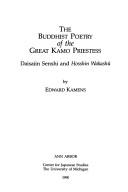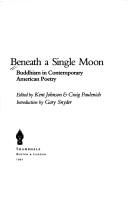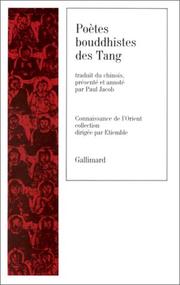| Listing 1 - 10 of 19 | << page >> |
Sort by
|
Book
Year: 1985 Publisher: Berlin : Akademie-Verlag,
Abstract | Keywords | Export | Availability | Bookmark
 Loading...
Loading...Choose an application
- Reference Manager
- EndNote
- RefWorks (Direct export to RefWorks)
Book
ISBN: 8930302378 Year: 1994 Publisher: 서울 集文堂
Abstract | Keywords | Export | Availability | Bookmark
 Loading...
Loading...Choose an application
- Reference Manager
- EndNote
- RefWorks (Direct export to RefWorks)
Book
ISBN: 9780674427730 0674427734 Year: 2015 Volume: 3 Publisher: Cambridge: Harvard university press,
Abstract | Keywords | Export | Availability | Bookmark
 Loading...
Loading...Choose an application
- Reference Manager
- EndNote
- RefWorks (Direct export to RefWorks)
The Therīgāthā, composed more than two millennia ago, is an anthology of poems in the Pali language by and about the first Buddhist women. These women were therīs, the senior ones, among ordained Buddhist women, and they bore that epithet because of their religious achievements. The poems they left behind are arguably among the most ancient examples of women’s writing in the world and they are unmatched for their quality of personal expression and the extraordinary insight they offer into the lives of women in the ancient Indian past—and indeed, into the lives of women as such.This new version of the Therīgāthā, based on a careful reassessment of the major editions of the work and printed in the Roman script common for modern editions of Pali texts, offers the most powerful and the most readable translation ever achieved in English.
Buddhist poetry. --- Pali poetry --- Buddhist poetry --- Pali poetry - Translations into English
Book
ISBN: 9780197586310 0197586317 Year: 2023 Publisher: New York Oxford University Press
Abstract | Keywords | Export | Availability | Bookmark
 Loading...
Loading...Choose an application
- Reference Manager
- EndNote
- RefWorks (Direct export to RefWorks)
"The Hsu-Tang Library presents authoritative and eminently readable translations of classical Chinese literature, in bilingual editions, ranging across three millennia and the entire Sinitic world. This anthology opens up new religious and poetic worlds for readers. It consists of translations of poems written by Buddhist nuns from China's late imperial period (1368-1911). Appreciation of these poems is enhanced by individual biographical accounts for each of the sixty-five nun-poets and an Introduction to the historical, religious, and literary context of these poems, including a concise discussion of Chinese Buddhism and Chinese Buddhist poetry. The nuns in this anthology come from a range of backgrounds: some were placed in convents when very young; others were former palace ladies or courtesans who found refuge in the religious life; others were women left widowed or destitute in the wake of the various political and social upheavals of the times, especially the violent transition between the Ming and Qing dynasties in the mid-seventeenth century. This period was also marked by a flourishing of women's culture, as more and more women from the gentry-class began not only to receive the classical education required to write poetry, but also to have their works printed and circulated. Most of the poet-nuns in this volume were from this gentry class, and almost all of them had at least one collection of writings, usually poetry, printed in their names. Although most of these collections are now lost, some of their poems have fortunately been preserved in various anthologies from this period, including anthologies dedicated exclusively to women's poetry, as well as in collections of Buddhist records"--
Buddhist nuns --- Buddhist poetry --- Buddhist poetry, Chinese --- Poetry --- Chinese poetry --- Women authors --- Religious aspects --- Buddhism

ISBN: 0472128027 0939512416 0472880020 0472038311 9780472880027 9780472128020 9780939512416 Year: 1991 Publisher: Ann Arbor, Michigan : University of Michigan Press,
Abstract | Keywords | Export | Availability | Bookmark
 Loading...
Loading...Choose an application
- Reference Manager
- EndNote
- RefWorks (Direct export to RefWorks)
Senshi was born in 964 and died in 1035, in the Heian period of Japanese history (794–1185). Most of the poems discussed here are what may loosely be called Buddhist poems, since they deal with Buddhist scriptures, practices, and ideas. For this reason, most of them have been treated as examples of a category or subgenre of waka called Shakkyoka, “Buddhist poems.Yet many Shakkyoka are more like other poems in the waka canon than they are unlike them. In the case of Senshi’s “Buddhist poems,” their language links them to the traditions of secular verse. Moreover, the poems use the essentially secular public literary language of waka to address and express serious and relatively private religious concerns and aspirations. In reading Senshi’s poems, it is as important to think about their relationship to the traditions and conventions of waka and to other waka texts as it is to think about their relationship to Buddhist thoughts, practices, and texts.The Buddhist Poetry of the Great Kamo Priestess creates a context for the reading of Senshi’s poems by presenting what is known and what has been thought about her and them. As such, it is a vital source for any reader of Senshi and other literature of the Heian period.
Buddhism in literature --- Buddhism in literature. --- Senshi, --- Buddhist poetry

ISBN: 0877735352 9780877735359 Year: 1991 Publisher: Boston: Shambhala,
Abstract | Keywords | Export | Availability | Bookmark
 Loading...
Loading...Choose an application
- Reference Manager
- EndNote
- RefWorks (Direct export to RefWorks)
American poetry --- Buddhist poetry, American --- Buddhism in literature.
Book
ISBN: 9780814716830 0814716830 Year: 2007 Publisher: New York: New York University press,
Abstract | Keywords | Export | Availability | Bookmark
 Loading...
Loading...Choose an application
- Reference Manager
- EndNote
- RefWorks (Direct export to RefWorks)
Nanda has it all—youth, money, good looks and a kittenish wife who fulfils his sexual and emotional needs. He also has the Buddha, a dispassionate man of immense insight and self-containment, for an older brother. When Nanda is made a reluctant recruit to the Buddha’s order of monks, he is forced to confront his all-too-human enslavement to his erotic and romantic desires. Dating from the second century CE, Handsome Nanda portrays its hero’s spiritual makeover with compassion, psychological profundity and great poetic skill.
Buddhist poetry --- Gautama Buddha --- Nanda --- Friends and associates --- Buddhist poetry. --- Gautama Buddha - Friends and associates - Poetry --- Nanda - Poetry
Book
ISBN: 9789004449770 9789004449848 Year: 2021 Publisher: Leiden;Boston BRILL
Abstract | Keywords | Export | Availability | Bookmark
 Loading...
Loading...Choose an application
- Reference Manager
- EndNote
- RefWorks (Direct export to RefWorks)
""The echo of the stone/ where I carved the [Buddha's] honorable footprints/ reaches the Heaven, [...]". This book presents the transcription, translation, and analysis of Chinese (753 AD) and Japanese inscriptions (end of the 8th century AD) found on two stones now in the possession of the Yakushiji temple in Nara. All these inscriptions praise the footprints of Buddha, and more exactly their carvings in the stone. The language of the Japanese inscription, which consists of twenty-one poems, reflects the contemporary dialect of Nara. Its writing system shows a quite unique trait, being practically monophonic. The book is richly illustrated by photos of the temple and of the inscriptions"--
Buddhist poetry, Japanese --- Buddhist poetry, Japanese. --- Japanese poetry --- Buddhist inscriptions --- Inscriptions, Japanese --- Buddhist poetry, Chinese. --- Chinese poetry --- Inscriptions, Chinese --- History and criticism. --- Yakushiji (Nara-shi, Japan) --- Linguistics --- Linguistic science --- Science of language --- Language and languages

ISBN: 2070710920 9782070710928 Year: 1987 Volume: 64 Publisher: Paris: Gallimard,
Abstract | Keywords | Export | Availability | Bookmark
 Loading...
Loading...Choose an application
- Reference Manager
- EndNote
- RefWorks (Direct export to RefWorks)
Poetry --- Chinese literature --- Chinese literature: authors --- anno 700-799 --- anno 900-999 --- anno 800-899 --- anno 600-699 --- Chinese poetry --- Buddhist poetry, Chinese --- Translations into French --- Chinese Buddhist poetry --- Chinese poetry - Translations into French --- Chinese poetry - Tʻang dynasty, 618-907
Book
ISBN: 9780199935789 9780199935765 Year: 2013 Publisher: Oxford [etc.] Oxford University Press
Abstract | Keywords | Export | Availability | Bookmark
 Loading...
Loading...Choose an application
- Reference Manager
- EndNote
- RefWorks (Direct export to RefWorks)
Buddhism --- Buddhism and culture --- Buddhist poetry, Sinhalese --- History --- History and criticism. --- Alagiyavanna Mukaveṭi, --- Criticism and interpretation. --- Portugal --- Colonies --- Religion.
| Listing 1 - 10 of 19 | << page >> |
Sort by
|

 Search
Search Feedback
Feedback About UniCat
About UniCat  Help
Help News
News